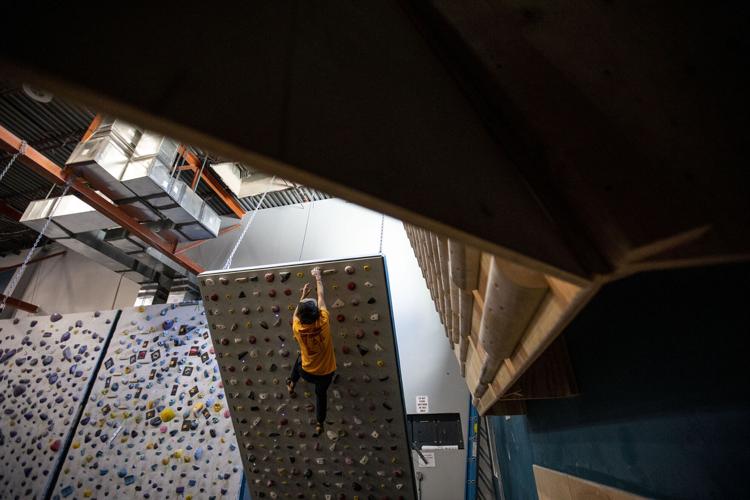From the app on his phone, Ian Richards selects the problem called Shin Ramen. LED dots flash on the board before him and his climbing partners, illuminating their route.
“Whaaat,” says Henry Sheridan.
“Whoooa,” remarks Luke Larson.
Such is the typical reaction to the MoonBoard, found here at Colorado Springs’ CityRock in the place where it is commonly found at gyms around the world: upstairs, as if to hide, as if not to scare guests entering the front door below.
It’s true, says local practitioner Toni Boyko: “Just looking at it is intimidating.”
She started on the MoonBoard in 2017. That’s when CityRock added it, joining the international phenomenon that took off upon the MoonBoard app launching just one year prior.
“There are a lot of people that are just total training fanatics,” says the gym’s owner, Joe Grosjean.
So in came the MoonBoard, measuring 12 feet high and 8 feet wide and angled at a harsh 40 degrees. Gravity poses an immediate challenge. Next are the holds, what one might call “junk holds” — slick pinches and crimps positioned in 18 rows and 11 columns, totaling 208.
They form what appears to be a limited grid.
“For the uninitiated, the MoonBoard is on its surface a relatively simple training tool that is in fact infinitely complex,” Boulder’s Matt Samet explains in a climbing.com essay.
A wider universe appears when one opens the MoonBoard app, as Richards does on this recent afternoon. At his aching fingertips are 27,896 problems and counting — routes that have been logged, tried and rated by climbers all over the globe.
Shin Ramen is just one of these. Just one to click and see represented by the LED dots, designating the holds where the climber’s hands must go. The feet can only go where the hands go, resulting in extreme reaches throughout the persistent fight against gravity.
The MoonBoard is a punishing test of strength. It’s kind of like maxing out on the bench press, Richards says. “If you’re training for power, this is a great way to do it.”
Samet’s essay, culminating in his mission on Staunton State Park’s Big Poppa route, captures the essence of a MoonBoard journey.
“By my third session on the MoonBoard,” he writes, “what had begun as hate and turned into curiosity and stoke had become a full-blown obsession.”
The season is turning in Colorado, the days shortening and temperatures dropping. It’s the time when more climbers turn to the gym. But for Richards and fellow purists, the ultimate remains the wild, vertical world beyond, the crag they’re trying to conquer constantly in mind. The gym is merely for training, as is the MoonBoard for a bolder bunch.
That includes Amity Warme, a University of Colorado at Colorado Springs student who has recently been traveling the country in a van, notching some of the most legendary ascents out there.
“Within a (MoonBoard) session, I’ll come back to problems I’ve worked on before,” she says, “but at no point would I choose a project on the MoonBoard over a project outside. It’s a training tool towards an end. It’s not the end itself.”
It’s useful indeed, Warme says, a one-of-a-kind. “I walk away from every MoonBoard session totally humbled. It doesn’t stop being hard, which I appreciate.”
As does a growing community, within which exists a sector that does see the MoonBoard as the ultimate. The MoonBoard has inspired a committed legion wrangling for bragging rights. They post their latest accomplishments on YouTube and Instagram. Cultish figures have risen to prominence, such as Ravioli Biceps, the buff and bearded crusher of MoonBoard records.
In the virtual world of the MoonBoard, average Joes duel with pros, taking on the same routes. On their phone, they can pull up the infamous Blade Runner entry by the great Ben Moon himself.
The pioneering, England-born climber traces the MoonBoard’s origins back to the late 1980s. Last year in a Rock and Ice essay, he recalled being “frustrated by a lack of training facilities” when he decided to fashion tilted, wooden boards to the ceiling of his cellar.
Moon credits the set-up for Hubble, considered the planet’s hardest climb at the time. It was but one bar-raising feat out of his cellar.
Along with strength-building, Moon foresaw his invention serving another purpose at gyms, where new routes are set any given month. But “the MoonBoard problems were there forever,” Moon wrote in Rock and Ice, “allowing users to have long-term training projects and benchmarks.”
It’s a helpful way to track progression, Grosjean says at CityRock. “But you gotta be a special person if you do it by yourself.”
Better to have comrades, “a few committed friends cheering each other on,” he says, watching Richards, Sheridan and Larson. “Like this.”
Waging battle with Shin Ramen, Richards’ sore, contorted body trembles against the board. One final move: a leap to the top hold.
“Come on, Ian,” Sheridan says.
“Yes, dude!” Larson says, as Richards sends himself upward. Success.
Next on his phone, Richards scrolls by a problem called Twisting in the Wind. “That sounds horrible,” he says. “Let’s look at that one.”
The dots light up on the board. “Whoooa,” Larson says. “This looks fun actually.”
Horrible, fun — just another day on the MoonBoard.
















(0) comments
Welcome to the discussion.
Log In
Keep it Clean. Please avoid obscene, vulgar, lewd, racist or sexually-oriented language.
PLEASE TURN OFF YOUR CAPS LOCK.
Don't Threaten. Threats of harming another person will not be tolerated.
Be Truthful. Don't knowingly lie about anyone or anything.
Be Nice. No racism, sexism or any sort of -ism that is degrading to another person.
Be Proactive. Use the 'Report' link on each comment to let us know of abusive posts.
Share with Us. We'd love to hear eyewitness accounts, the history behind an article.